belt AUDI Q3 2016 Owners Manual
[x] Cancel search | Manufacturer: AUDI, Model Year: 2016, Model line: Q3, Model: AUDI Q3 2016Pages: 252, PDF Size: 62.81 MB
Page 4 of 252
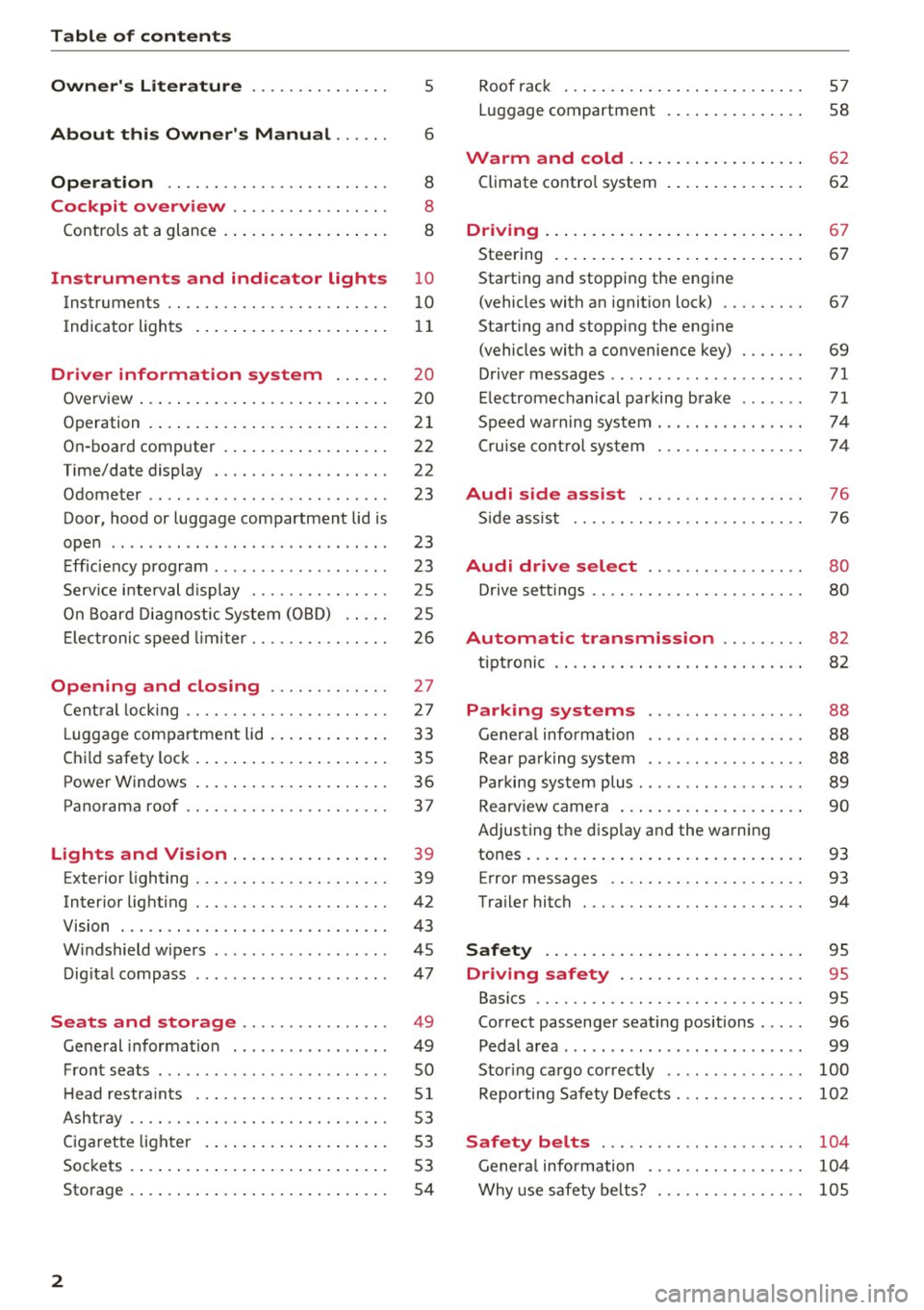
Table of content s
Owner' s Lit e rature
5
About this Own er's Manual . . . . . . 6
Opera tion . . . . . . . . . . . . . . . . . . . . . . . . 8
Cockpit overview . . . . . . . . . . . . . . . . . 8
Controls at a glance . . . . . . . . . . . . . . . . . . 8
Instruments and indicator lights 10
Instruments . . . . . . . . . . . . . . . . . . . . . . . . 10
Indicator lights . . . . . . . . . . . . . . . . . . . . . 1 1
Driver information system . . . . . . 20
Overview . . . . . . . . . . . . . . . . . . . . . . . . . . . 20
Operation . . . . . . . . . . . . . . . . . . . . . . . . . .
2 1
On-boa rd computer . . . . . . . . . . . . . . . . . . 22
Time/date display . . . . . . . . . . . . . . . . . . . 22
Odometer . . . . . . . . . . . . . . . . . . . . . . . . . . 23
Door, hood or luggage compartment lid is
open . . . . . . . . . . . . . . . . . . . . . . . . . . . . . . 23
Eff iciency program . . . . . . . . . . . . . . . . . . . 23
Service i nterval d isplay . . . . . . . . . . . . . . . 25
O n Board Diagnostic System (O BD) . . . . . 25
E lec tronic speed limiter. . . . . . . . . . . . . . . 26
Opening and closing . . . . . . . . . . . . . 27
Cent ral locking . . . . . . . . . . . . . . . . . . . . . . 27
L uggage compartment lid . . . . . . . . . . . . . 33
Chi ld safety lock . . . . . . . . . . . . . . . . . . . . . 35
Power Windows . . . . . . . . . . . . . . . . . . . . . 36
Panorama roof . . . . . . . . . . . . . . . . . . . . . . 37
Lights and Vision . . . . . . . . . . . . . . . . . 39
Exterior lighting . . . . . . . . . . . . . . . . . . . . . 39
Interior lighting . . . . . . . . . . . . . . . . . . . . . 42
V1s1on . . . . . . . . . . . . . . . . . . . . . . . . . . . . . 43
W indshield wipers . . . . . . . . . . . . . . . . . . . 45
D ig ita l compass . . . . . . . . . . . . . . . . . . . . . 47
Seats and stor age . . . . . . . . . . . . . . . . 49
General informa tion . . . . . . . . . . . . . . . . . 49
F ront seats . . . . . . . . . . . . . . . . . . . . . . . . . SO
H ead restra ints . . . . . . . . . . . . . . . . . . . . .
5 1
Ashtray . . . . . . . . . . . . . . . . . . . . . . . . . . . . 53
Cigarette ligh ter . . . . . . . . . . . . . . . . . . . . 5 3
Sockets . . . . . . . . . . . . . . . . . . . . . . . . . . . . 53
Storage . . . . . . . . . . . . . . . . . . . . . . . . . . . . 54
2
Roof rack ... .. .. .. .. ... . .. .... ... . .
Luggage compartment . ... .. .... ... . . 57
58
Warm and cold .. .. .. .. .. .... ... .. 62
Climate contro l system . . . . . . . . . . . . . . . 62
Driving ... .. .. .. .. .. .. . ... .... ... .. 67
Steering . . . . . . . . . . . . . . . . . . . . . . . . . . . 67
Starting and stopping the engine (vehicles with an ignit ion lock) . . . . . . . . . 67
Start ing and stopping the eng ine
(vehicles with a convenience key) . . . . . . . 69
Driver messages .. ... ...... ....... .. .
E lectromechanical parking brake ...... .
Speed warning system . ... .. ... ... .. . .
Cru ise cont rol sys tem
Audi side assist ... ........ ..... . .
Side assist .. .. .. .. .. .. ........... . .
Audi drive select .. ..... ....... .. .
D rive sett ings .. .. .. .. ............. . .
Automatic transmission ........ .
71
71
74
74
76
76
80
80
82
t iptronic . . . . . . . . . . . . . . . . . . . . . . . . . . . 82
Parking systems
Genera l information .. ..... ....... .. .
Rear park ing system .. .. ........... . .
Parking sys tem plus . .. ... .......... . .
Rearv iew camera ... .. .. .. .. .... ... . .
Adjusting the disp lay and the warning
tones .. ... .. .. .. .. .. ... .. ..... ... . .
Error messages .. .. .. ............. . .
Trailer hitch ... .. .. .. ............. . .
Safety ... .. .. .. .. .. .. .. .. .... ... . .
Driving safety ... .. ............. . .
88
88
88
89
90
93
93
94
95
95
Bas ics . . . . . . . . . . . . . . . . . . . . . . . . . . . . . 95
Correct passenger seat ing positions . . . . . 96
Pedal a rea . . . . . . . . . . . . . . . . . . . . . . . . . . 99
Stor ing ca rgo cor rectly . . . . . . . . . . . . . . .
100
Reporting Safety Defec ts. . . . . . . . . . . . . . 102
Safety belts . . . . . . . . . . . . . . . . . . . . . . 104
Genera l information . . . . . . . . . . . . . . . . . 104
Why use s afety be lts? . . . . . . . . . . . . . . . . 105
Page 5 of 252
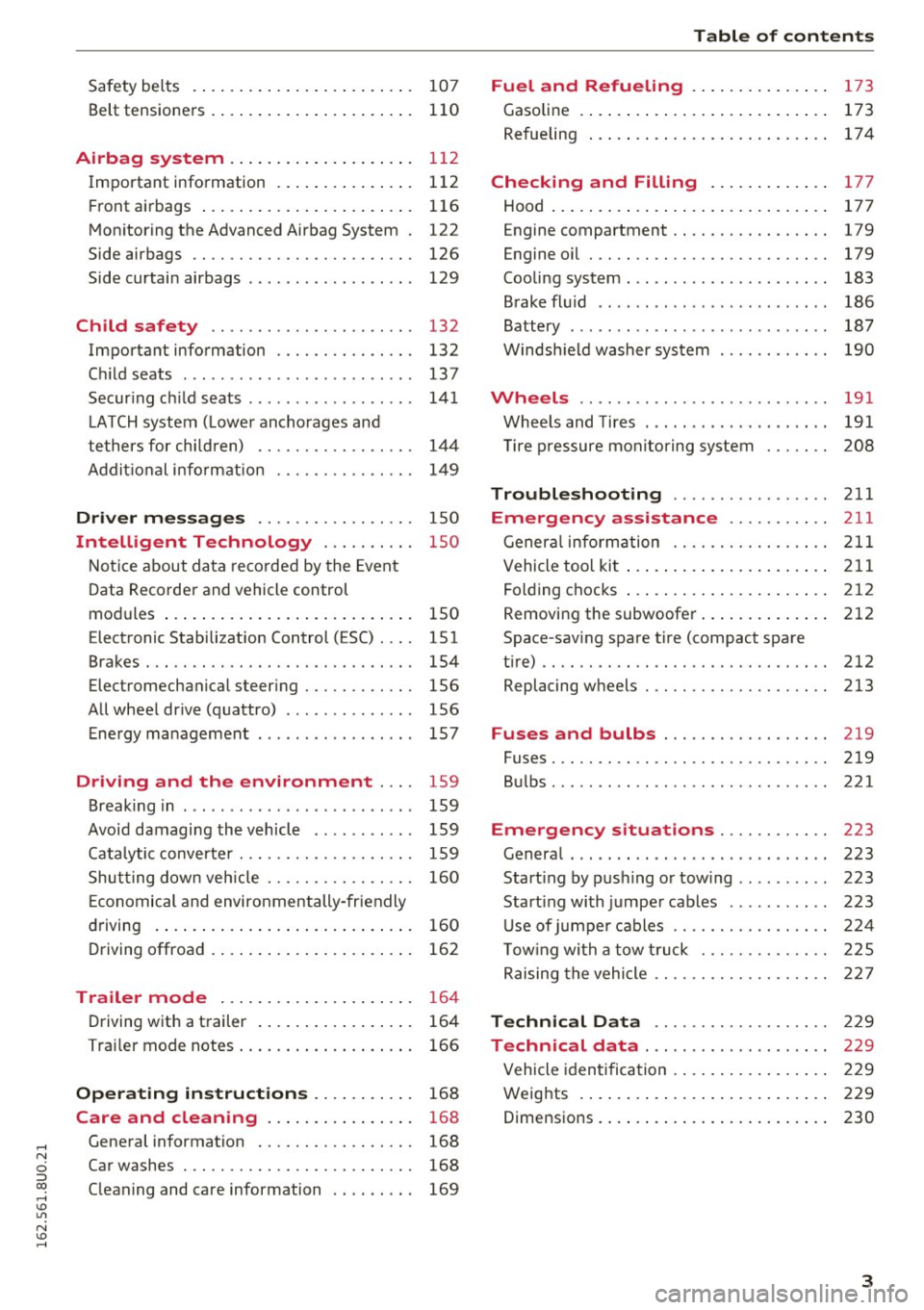
Safety belts . . . . . . . . . . . . . . . . . . . . . . . . 107
Belt tensioners . . . . . . . . . . . . . . . . . . . . . . 110
Airbag system ............... .... . 112
Important information . . . . . . . . . . . . . . . 112
Front airbags ...................... . 116
Monitoring the Advanced Airbag System . 122
Side airbags . . . . . . . . . . . . . . . . . . . . . . . . 126
Side curtain airbags . . . . . . . . . . . . . . . . . . 129
Child safety . . . . . . . . . . . . . . . . . . . . . . 132
Important information . . . . . . . . . . . . . . . 132
Child seats ............... ...... ... . 13 7
Securing child seats . . . . . . . . . . . . . . . . . . 141
LATCH system (Lower anchorages and
tethers for children) . . . . . . . . . . . . . . . . .
144
Addit ional information 149
Driver messages . . . . . . . . . . . . . . . . . 150
Intelligent Technology . . . . . . . . . . 150
Notice about data recorded by the Event
Data Recorder and vehicle control
modul es . . . . . . . . . . . . . . . . . . . . . . . . . . .
150
Electronic Stabilization Control ( ESC) . . . . 151
Brakes . . . . . . . . . . . . . . . . . . . . . . . . . . . . . 154
Electromechanical steering . . . . . . . . . . . . 156
All wheel drive (quattro) . . . . . . . . . . . . . . 156
Energy management . . . . . . . . . . . . . . . . . 157
Driving and the environment . . . . 159
Breaking in . . . . . . . . . . . . . . . . . . . . . . . . . 159
Avoid damaging the vehicle . . . . . . . . . . . 159
Catalytic converter . . . . . . . . . . . . . . . . . . . 159
Shutting down vehicle . . . . . . . . . . . . . . . . 160
Economical and environmentally-friendly
driving . . . . . . . . . . . . . . . . . . . . . . . . . . . .
160
Driving offroad . . . . . . . . . . . . . . . . . . . . . . 162
Trailer mode . . . . . . . . . . . . . . . . . . . . . 164
Driving with a trailer . . . . . . . . . . . . . . . . . 164
Trailer mode notes . . . . . . . . . . . . . . . . . . . 166
Operating instructions . . . . . . . . . . . 168
Care and cleaning . . . . . . . . . . . . . . . . 168
General information . . . . . . . . . . . . . . . . . 168
Car washes . . . . . . . . . . . . . . . . . . . . . . . . . 168
Cleaning and care information . . . . . . . . . 169
Table of contents
Fuel and Refueling . . . . . . . . . . . . . . .
173
Gasoline . . . . . . . . . . . . . . . . . . . . . . . . . . . 173
Refueling . . . . . . . . . . . . . . . . . . . . . . . . . . 17 4
Checking and Filling . . . . . . . . . . . . . 177
Hood . . . . . . . . . . . . . . . . . . . . . . . . . . . . . . 177
E ngine compa rtment . . . . . . . . . . . . . . . . . 179
Engine oil . . . . . . . . . . . . . . . . . . . . . . . . . . 179
Cooling system . . . . . . . . . . . . . . . . . . . . . . 183
Brake fluid . . . . . . . . . . . . . . . . . . . . . . . . . 186
Battery . . . . . . . . . . . . . . . . . . . . . . . . . . . . 187
Windshield washer system 190
Wheels ........ .. ................. 191
Wheels and Tires . . . . . . . . . . . . . . . . . . . . 191
Tire pressure monitoring system 208
Troubleshooting ............. .. .. 211
Emergency assistance . . . . . . . . . . . 211
General information . . . . . . . . . . . . . . . . . 211
Vehicle tool kit . . . . . . . . . . . . . . . . . . . . . . 211
Folding chocks . . . . . . . . . . . . . . . . . . . . . . 212
Removing the subwoofer............. . 212
Space-saving spare tire (compact spare
tire).. .. .. .. .. .. .. .... ... .. .. .. .. ..
212
Replacing wheels . . . . . . . . . . . . . . . . . . . . 213
Fuses and bulbs . . . . . . . . . . . . . . . . . . 219
Fuses. .... .. .. .. .. ....... ........ .. 219
Bulbs . . . . . . . . . . . . . . . . . . . . . . . . . . . . . . 221
Emergency s ituations . . . . . . . . . . . . 223
General . . . . . . . . . . . . . . . . . . . . . . . . . . . . 223
Starting by pushing or towing . . . . . . . . . . 223
Start ing with jumper cables ........... 223
Use of jumper cables . . . . . . . . . . . . . . . . . 224
Towing with a tow truck . . . . . . . . . . . . . . 225
Raising the vehicle . . . . . . . . . . . . . . . . . . . 227
Technical Data . . . . . . . . . . . . . . . . . . . 229
Technical data . . . . . . . . . . . . . . . . . . . . 22 9
Vehicle identification . . . . . . . . . . . . . . . . . 229
Weights . . . . . . . . . . . . . . . . . . . . . . . . . . . 229
D . . 1mens1ons
.. .. . ... ................ . 230
3
Page 17 of 252
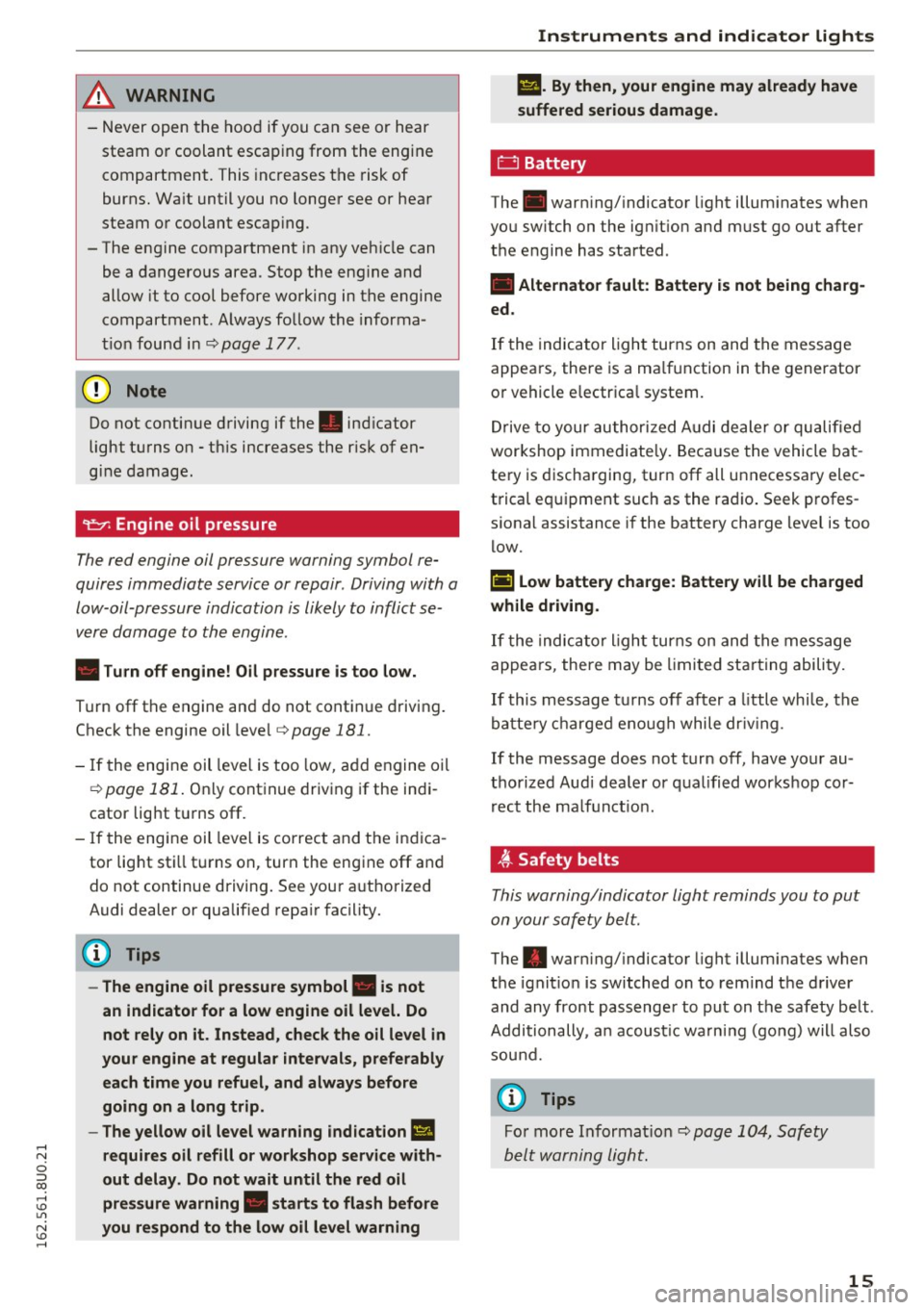
& WARNING
-Never open the hood if you can see or he ar
steam or coolant escaping from the engine
compartment. This inc reases t he risk of
burns . Wa it until you no longe r see or hea r
steam o r coolant escap ing .
- The engine compartment in any veh icle can
be a dangerous area. Stop the eng ine and
allow it to coo l before working in t he engine
compartment . A lways fo llow the informa
ti on foun d in ¢
page 177 .
(D Note
Do not contin ue d riving if the. indicator
light turns o n -thi s increases the r isk of en
gi ne damage.
"t!:r. Engine oil pressure
The red engine oil pressure warning symbol re
quires immediate service or repair . Driving with a
low-oil-pressure indication is likely to inflict se
v e re damage to the engine .
• Turn off engine! Oil pressure is too low.
Tur n off the engine an d do not cont inue d riving .
C hec k the engine oil leve l¢
page 181.
- If the engine oil leve l is too low, a dd engine o il
¢
page 181 . Only cont inue driv ing if the ind i
cator lig ht t urns off.
- If the engine oil leve l is correc t and the i ndica
tor light sti ll tur ns on, turn the eng ine off and
do not continue driving . See you r auth orized
Audi dealer or qualif ied repa ir facility.
@ Tips
-The engine oil pressure symbol. is not
an indicator for a low engine oil level. Do
not rely on it. Instead, check the oil level in
your engine at regular intervals, preferably
each time you refuel, and always before
going on a long trip.
- The yellow oil level warning indication
Ill
requires oil r efill or workshop service with
out delay . Do not wait until the red oil
pressure warning. starts to flash before
you respond to the low oil level warning Instruments and ind
icator lights
IIJ. By then, your engine may already have
suffered serious damage.
0 Battery
The . warn ing/ indicato r light illum inates when
you sw itch on the ig nition and m ust go out after
t h e e ngine has started .
• Alternator fault: Battery is not being charg
ed .
If the indic ator ligh t turns on and the message
appea rs, the re is a ma lfunction in t he generator
o r vehicle e lectr ica l system.
D rive to your au thor ized A udi dealer or qu alified
wor kshop im medi ate ly. Bec au se the vehicle bat
te ry is d ischa rgin g, turn off all u nnecessary elec
t rical eq uipment such as the rad io . Seek p rofes
s iona l assistance if the battery charge level is too
low.
(•) Low battery charge: Battery will be charged
while driving .
If the indic ator ligh t turns on an d the mess age
appea rs, there may be limi ted sta rting abili ty .
If this message turns off after a little whi le, the
ba tte ry ch arge d eno ugh while dr iv ing .
If the message does not turn off, have yo ur au
t h orized Audi de aler or q ual ified works hop cor
r ec t t he ma lf u nct ion.
4t Safety belts
This warning/indicator light reminds you to put
on your safety b elt.
The . war ning/ indicator light illum inates when
t h e ignit io n is switched on to remind t he driver
and any front passenge r to put on the safety be lt.
Addi tionally , a n acous tic w arnin g (go ng) will also
sou nd.
@ Tips
Fo r mor e In forma tion ¢ pag e 104, Saf ety
bel t warning light .
15
Page 51 of 252
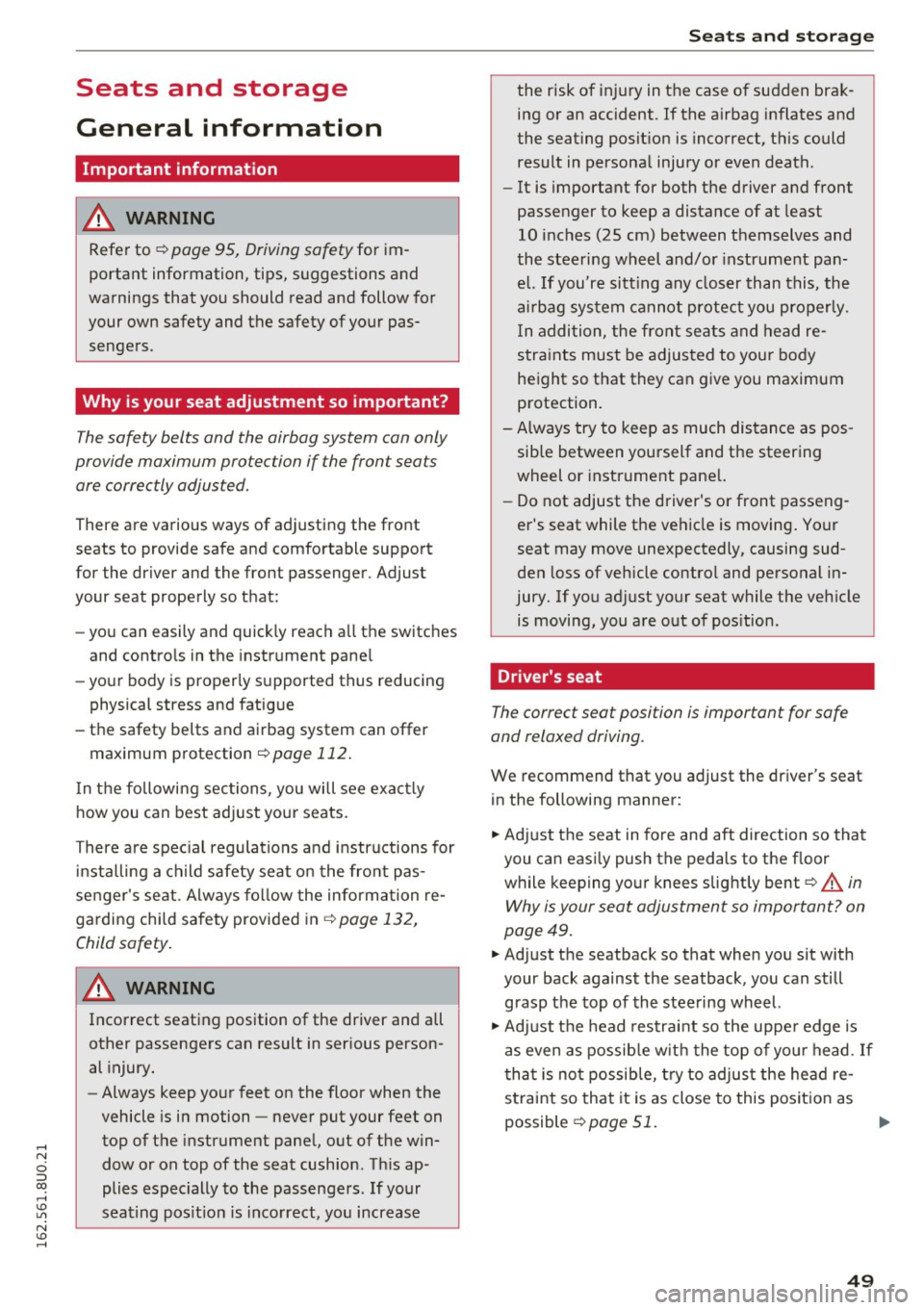
Seats and storage
General information
Important information
A WARNING
-
Refer to ¢ page 95, Driving safety for i m
portant information, tips, suggestions and
warnings that you should read and follow for
your own safety and the safety of your pas
sengers.
Why is your seat adjustment so important?
The safety belts and the airbag system can only
provide maximum protection if the front seats
are correctly adjusted.
There are various ways of adjusting the front
seats to provide safe and comfortable support
for the driver and the front passenger. Adjust
your seat properly so that:
- you can easily and quick ly reach all the switches
and controls in the instrument pane l
- your body is properly supported thus reducing
physical stress and fatigue
- the safety belts and airbag system can offer
maximum protection
¢ page 112.
In the following sections, you will see exact ly
how you can best adjust your seats.
There are special regulations and instructions for in stalling a ch ild safety seat on the front pas
senger's seat . Always follow the information re
garding child safety provided in
¢ page 132,
Child safety .
A WARNING
Incorrect seating position of the driver and all
other passengers can result in serious person
al injury.
- Always keep yo ur feet on the floor when the
vehicle is in motion -never put your feet on
top of the instrument pane l, out of the win
dow or on top of the seat cushion. Th is ap
plies especially to the passengers. If your
seating pos it ion is inco rrect, you increase
Seat s and sto rage
the risk of injury in the case of sudden brak
ing or an accident. If the airbag inflates and
the seating posit ion is incorrect, th is could
result in persona l injury or even death.
- It is important for both the driver and front
passenger to keep a distance of at least
10 inches (25 cm) between themselves and
the steering wheel and/or instrument pan
el. If you're sitt ing any closer than this, the
ai rbag system cannot protect you properly.
I n addition, the front seats and head re
stra ints must be adjusted to you r body
height so that they can give you maximum
protection.
- Always try to keep as much dis tance as pos
sible between yourself and the steering
wheel or instrument pane l.
- Do not adjust the driver's o r front passeng
er's seat while the vehicle is moving . Your
seat may move unexpectedly, causing sud
den loss of vehicle contro l and personal in
jury. If you ad just your seat while the veh icle
is moving, you are o ut of pos ition.
Driver's seat
The correct seat position is important for safe
and relaxed driving.
We recommend that you adjust the driver's seat
in the following manner:
.. Adjust the seat in fore and aft direction so that
you can easi ly push the pedals to the f loor
while keeping yo ur knees slight ly bent ¢
A in
Why is your seat adjustment so important? on
page 49.
.. Adjust the seatback so that when you sit with
your back against the seatback, you can still
grasp the top of the stee ring wheel.
.. Adj ust the head restra int so the uppe r edge is
as
even as possib le w it h the top of yo ur head. If
tha t is no t possible, t ry to adjus t the hea d re
st raint so tha t it is as close to this pos it ion as
possible
¢ page 51. .,.
49
Page 52 of 252
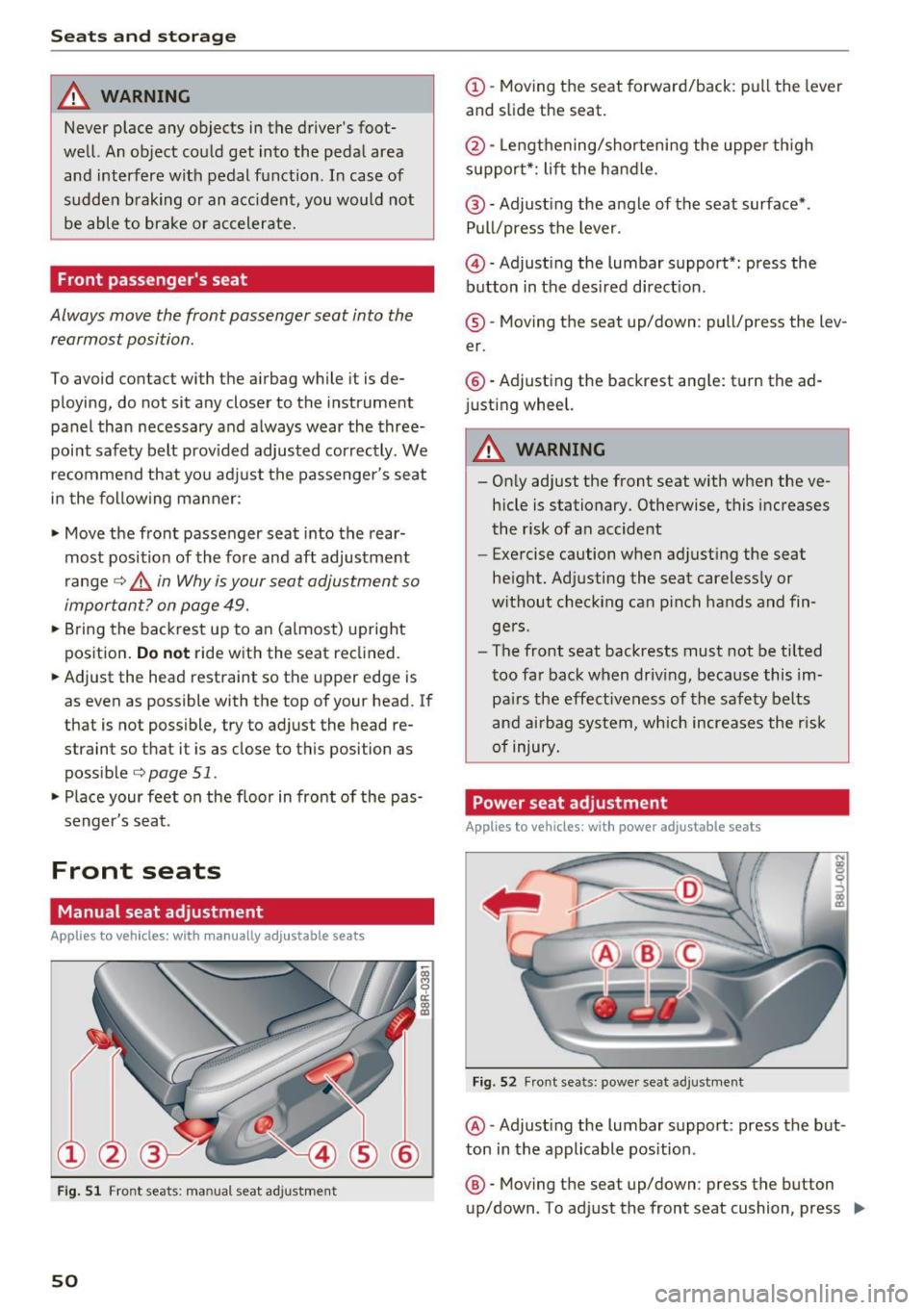
Seats and storage
_& WARNING
Never place any objects in the driver's foot
well. An object could get into the pedal area and interfere with pedal function. In case of
sudden braking or an accident, you would not
be able to brake or accelerate.
Front passenger's seat
Always move the front passenger seat into the
rearmost position.
To avoid contact with the airbag while it is de
ploying, do not sit any closer to the instrument
panel than necessary and always wear the three
point safety belt provided adjusted correctly. We
recommend that you adjust the passenger's seat
i n th e following manner:
• Move the front passenger seat into the rear
most position of the fore and aft adjustment
range ¢,&.
in Why is your seat adjustment so
important? on page 49.
• Bring the backrest up to an (almost) upright
position. Do not ride with the seat reclined.
• Adjust the head restraint so the upper edge is
as even as possible with the top of your head. If
that is not possible, try to adjust the head re
straint so that it is as close to this position as
possible¢
page 51.
• Place your feet on the floor in front of the pas
senger's seat.
Front seats
Manual seat adjustment
Applies to vehicles: with manually adjustable seats
Fig. 51 Front seats: manua l seat adjustme nt
50
(D -Moving the seat forward/back: pull the lever
and slide the seat.
@-Lengthen ing/shortening the upper thigh
support*: lift the handle.
@ -Adjusting the angle of the seat surface*.
Pull/press the lever.
@) -Adjusting the lumbar support*: press the
button in the desired direction.
® -Moving the seat up/down: pull/press the lev
er.
@ -Adjusting the backrest angle: turn the ad
ju sting wheel.
_& WARNING
-Only adjust the front seat with when the ve
hicle is stationary. Otherwise, this increases
the risk of an accident
- Exercise caution when adjusting the seat
height. Adjusting the seat carelessly or
without checking can pinch hands and fin gers.
- The front seat backrests must not be tilted
too far back when driving, because this im
pairs the effectiveness of the safety belts
and airbag system, which increases the risk
of injury.
Power seat adjustment
Applies to vehicles: with power adjustable seats
Fig . 52 Front seats: power seat adjustme nt
@ -Adjusting the lumbar support: press the but
ton in the applicable position.
@ -Moving the seat up/down: press the button
up/down. To adjust the front seat cushion, press
IJJI,
Page 53 of 252
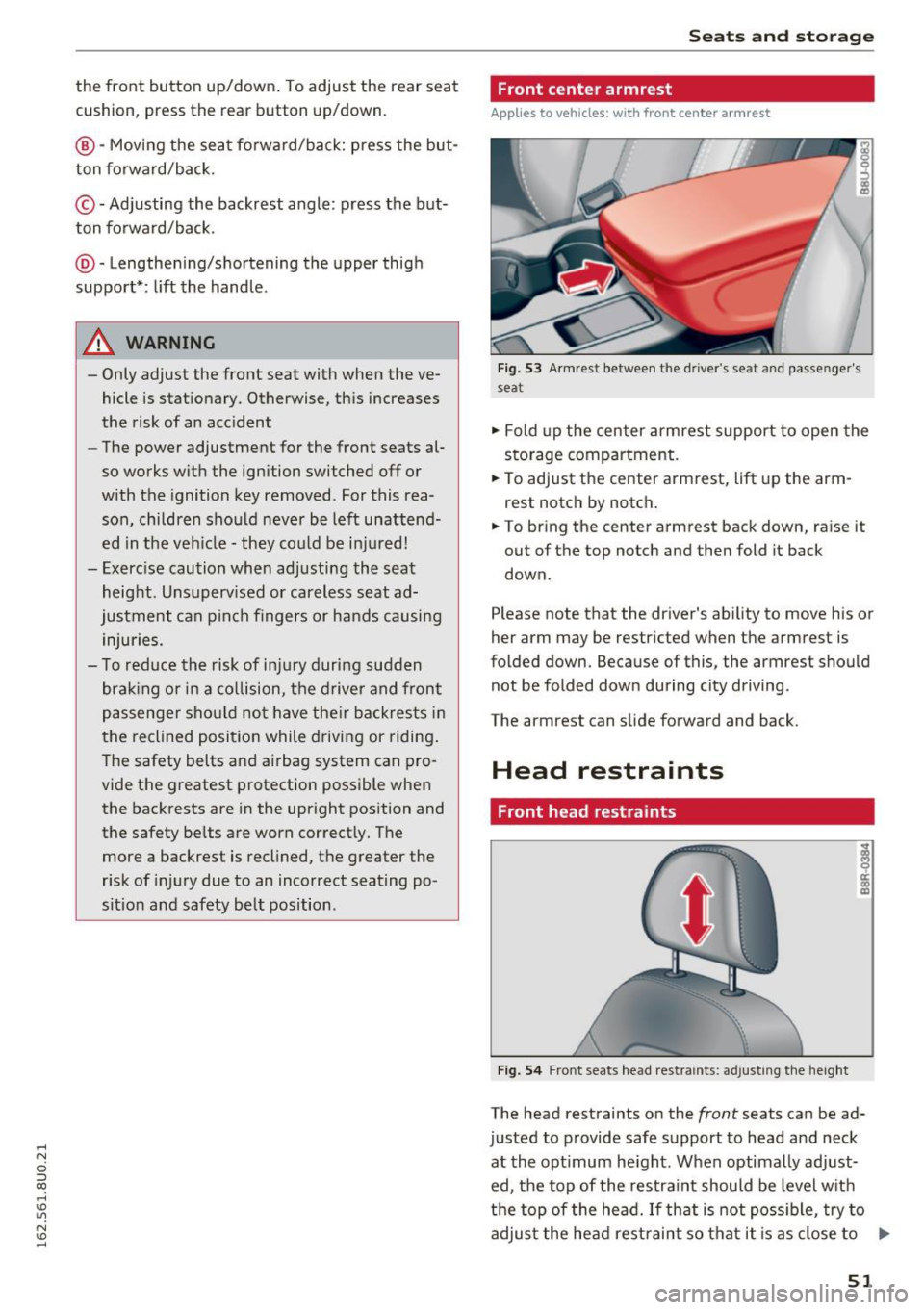
.... N
c:i :::J CX)
.... I.Cl U"I
N I.Cl ......
the front button up/down. To adjust the rear seat
cushion, press the rear button up/down.
@-Moving the seat forward/back: press the but
ton forward/back.
© -Adjusting the backrest angle: press the but
ton forward/back.
@ -Lengthen ing/shortening the upper thigh
support* : lift the handle .
.&_ WARNING
- Only adjust the front seat with when the ve
hicle is stationary. Otherwise, this increases
the risk of an acc ident
- The power adjustment for the front seats al
so works with the ignition switched off or
with the ignition key removed . For this rea
son, children should never be left unattend
ed in the veh icle -they could be injured!
- Exerc ise caution when adjusting the seat
height. Unsupervised or careless seat ad
justment can p inch fingers or hands causing
injuries.
- To reduce the risk of injury during sudden
braking or in a collision, the driver and front
passenger should not have their backrests in
the reclined position while driving or riding .
The safety belts and airbag system can pro
vide the greatest protection possible when
the backrests are in the upright position and
the safety belts are worn correctly. The
more a backrest is reclined, the greater the
risk of injury due to an incorrect seating po
sition and safety belt position .
Seats and storage
Front center armrest
Applies to vehicles: with front center armrest
Fig. 53 Armrest betwee n the dr iver 's seat and passenger's
seat
.,. Fold up the center armrest support to open the
storage compartment .
.,. To adjust the center armrest, lift up the arm
rest notch by notch.
.,. To bring the center armrest back down, raise it
out of the top notch and then fold it back
down.
Please note that the driver's ability to move his or
her arm may be restricted when the armrest is
folded down. Because of this, the armrest should
not be folded down during city driving.
The armrest can slide forward and back.
Head restraints
Front head restraints
Fig. 54 Front seats head res traints: adjusting the height
The head restraints on the front seats can be ad
justed to provide safe support to head and neck at the opt imum height . When optimally adjust-
ed, the top of the restraint should be level with
the top of the head. If that is not poss ible, try to
adjust the head restraint so that it is as close to ..,.
51
Page 54 of 252
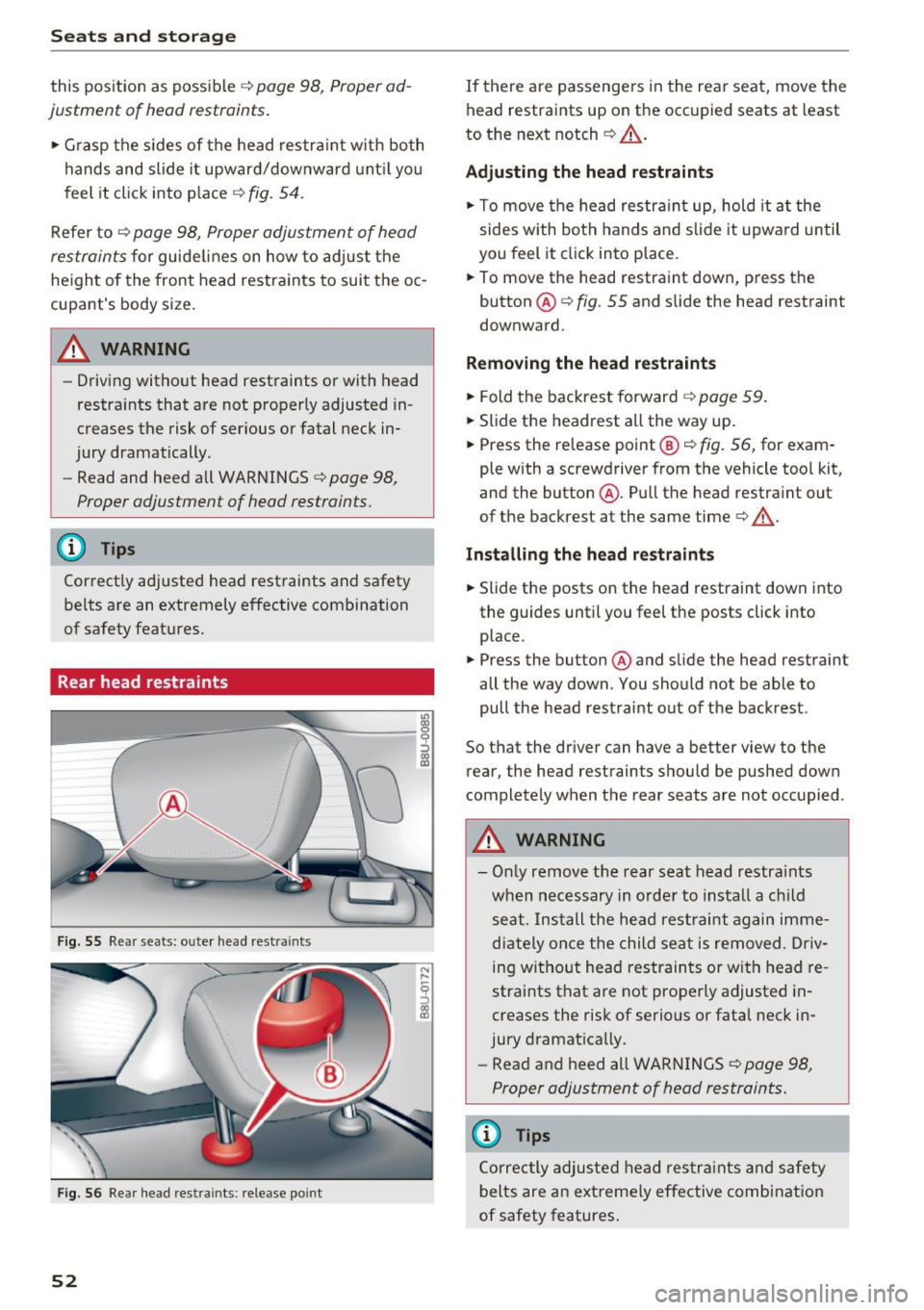
Sea ts and stor age
this position as possible ¢ page 98, Proper ad
justment of head restraints .
.. Grasp the sides of the head restra in t w ith both
hands and slide it upward/downward unt il you
f eel it click into p lace
¢ fig. 54.
Refer to ¢ page 98, Proper adjustment of head
restraints
f or guide lines on how to adjust the
height of the front head restraints to suit the oc
cupant's body size.
_& WARNING
- Driving without head restraints or with head
restra ints that are not properly adjusted in
creases the risk of serious or fatal neck in
jury dramatically.
- Read and heed all WARNINGS¢
page 98,
Proper adjustment of head restraints.
@ Tips
Cor rect ly adjusted head restraints and safety
be lts are an extremely effective combination
of safety features .
Rear head restraints
F ig . 5 5 Rear seats: oute r head rest ra in ts
Fig . 56 Rear head restra ints: release po int
52
If there are passengers in the rear seat, move the
head restraints up on the occ upied seats at least
to the next notch
¢ A .
Adjusting the head restraints
.. To move the head restra int up, hold it a t the
sides with both hands and s lide it upward until
you feel it click into place.
.. To move the head restraint down, press the
button @¢
fig. 55 and s lide the head restraint
downward .
Remo ving the head r estraint s
.. Fold the backrest forwar d
<=.> page 59.
.. Slide the headrest all the way up.
.. Press the release point@¢
fig. 56, for exam
ple with a screwdriver from the vehicle tool kit,
and the button @. Pull the head restra int out
of the backrest at the same time<=.>&.
Installing the h ead re straints
.. Slide the posts on the head restraint down into
the guides until you feel the posts click into
place .
.. Press the button @ and slide the head restraint
all the way down . You should not be able to
pull the head restraint out of the backrest.
So that the driver can have a better view to the rear, the head restraints shou ld be pushed down
completely when the rear seats are not occupied .
_& WARNING
- Only remove the rear seat head restra ints
when nec essary in order to insta ll a ch ild
seat. In stall the he ad restraint again imme
diately once the child seat is removed. D riv
ing without head restrain ts or with head re
straints that are not prope rly adjusted in
creases the risk of serious or fatal neck in
jury dramat ically .
- Read and heed all WA RNINGS
¢page 98,
Proper adjustment of head restraints.
(D Tips
Correc tly adju ste d h ead res tra ints and safety
belts are an extreme ly effective comb ination
of safety features .
-
Page 61 of 252
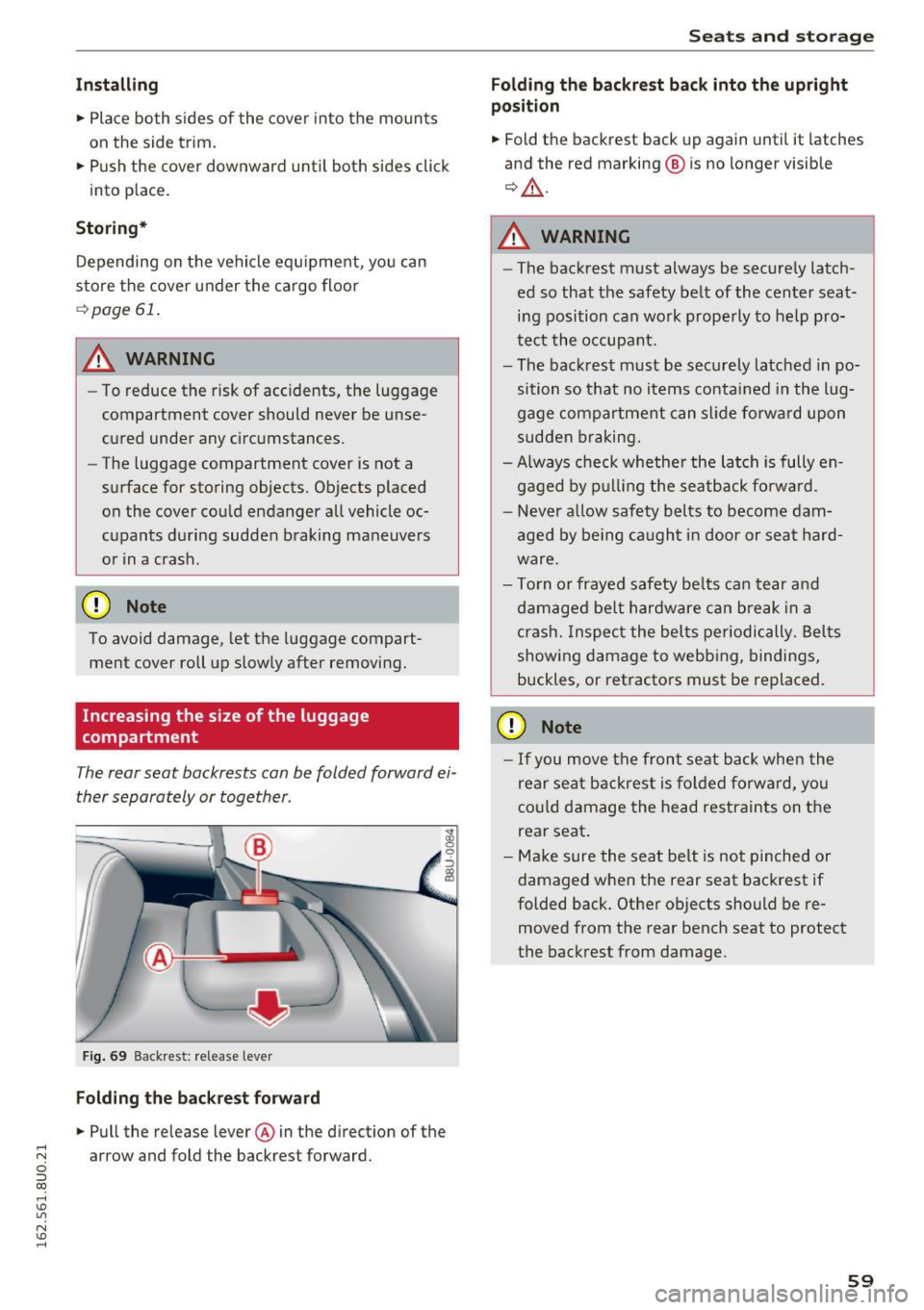
Installing
• Place both sides of the cover into the mounts
on the side trim.
• Push the cover downward until both sides click
into place.
Storing*
Depending on the vehicle equipment, you can
store the cover under the cargo floor
¢page 61.
A WARNING
-To reduce the risk of accidents, the luggage
compartment cover should never be unse
cured under any circumstances .
- The luggage compartment cover is not a
surface for storing objects. Objects placed
on the cover could endanger all vehicle oc
cupants during sudden braking maneuvers
or in a crash.
CD Note
To avoid damage, let the luggage compart
ment cover roll up slowly after removing.
Increasing the size of the luggage
compartment
The rear seat backrests can be folded forward ei
ther separately or together .
Fig. 69 Backrest: release lever
Folding the backrest forward
• Pull the release lever @in the direction of the .... N arrow and fold the backrest forward. c:i ::J CX)
.... I.Cl U"I
N I.Cl ......
Seats and storage
Folding the backrest back into the upright
position
• Fold the backrest back up again until it latches
and the red marking ® is no longer visible
¢ ,&..
A WARNING
--The backrest must always be securely latch-
ed so that the safety belt of the center seating position can work properly to help pro
tect the occupant.
- The backrest must be securely latched in po
sition so that no items contained in the lug
gage compartment can slide forward upon
sudden braking.
- Always check whether the latch is fully en
gaged by pulling the seatback forward.
- Never allow safety belts to become dam
aged by being caught in door or seat hard
ware.
- Torn or frayed safety belts can tear and
damaged belt hardware can break in a
crash. Inspect the belts periodically. Belts
showing damage to webbing, bindings,
buckles, or retractors must be replaced.
CD Note
- If you move the front seat back when the
rear seat backrest is folded forward, you
could damage the head restraints on the
rear seat.
- Make sure the seat belt is not pinched or
damaged when the rear seat backrest if
folded back. Other objects should be re
moved from the rear bench seat to protect
the backrest from damage.
59
Page 63 of 252
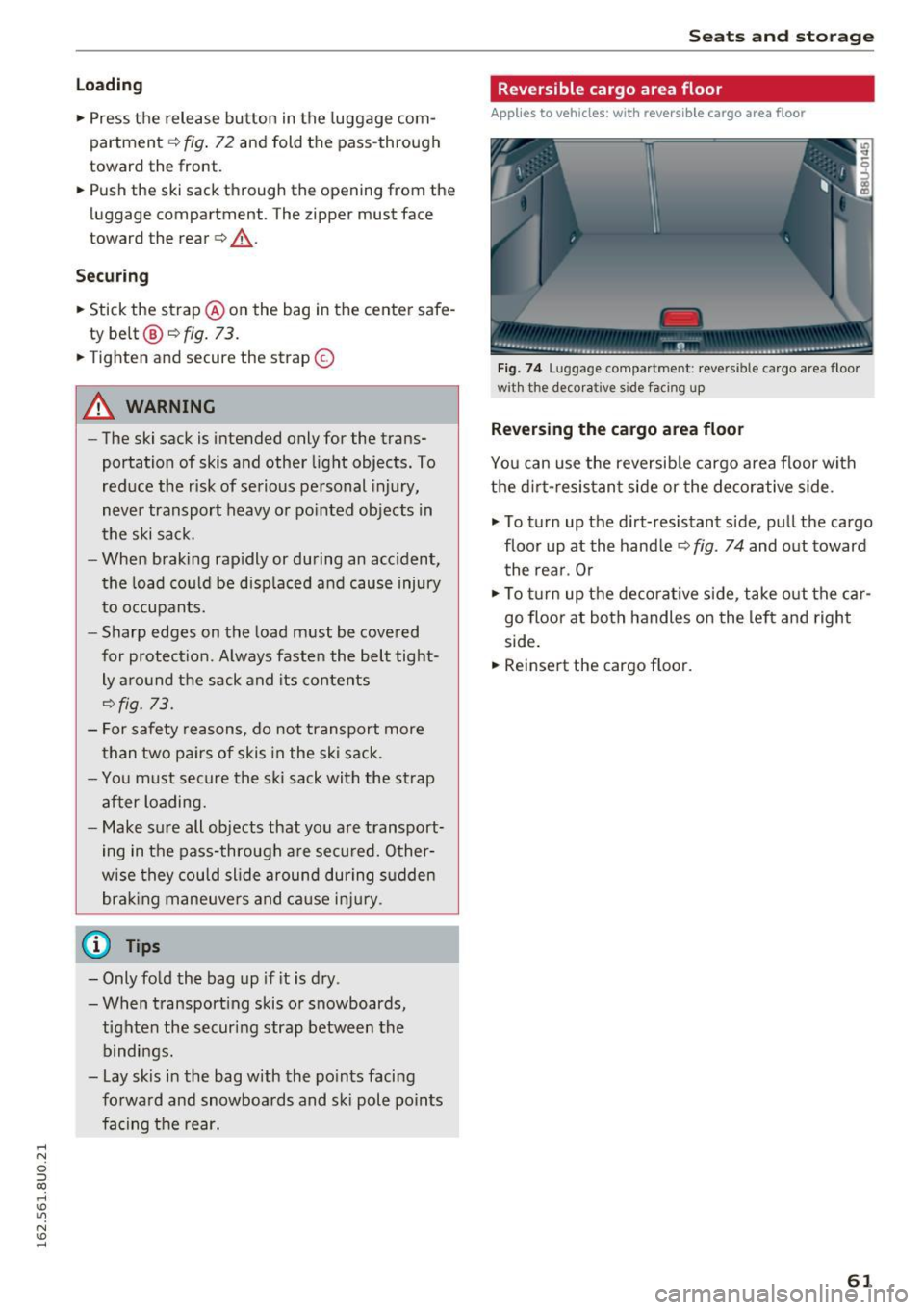
.... N
c:i :::J CX)
.... I.Cl U"I
N I.Cl ......
Loading
• Press the release button in the luggage com
partment
c:> fig. 72 and fold the pass-through
toward the front.
• Push the ski sack through the opening from the
luggage compartment . T he zipper must face
toward the rear
c:> ,& .
Securing
• Stick the strap @on th e bag in the center safe
ty belt @c:> fig. 73.
• Tighten and secure the strap©
A WARNING
-The ski sack is intended only for the trans
portation of skis and other light objects. To
reduce the risk of serious personal injury,
never transport heavy or pointed objects in
the ski sack.
- When braking rapidly or during an accident ,
the load could be displaced and cause injury
to occupants.
- Sharp edges on the load must be covered
for protection. Always fasten the belt tight
ly around the sack and its contents
c:>fig . 73.
- For safety reasons, do not transport more
than two pairs of skis in the ski sack .
- You must secure the ski sack with the strap
after loading.
- Make sure all objects that you are transport
ing in the pass-through are secured. Other
wise they could slide around during sudden
braking maneuvers and cause injury .
(D Tips
-Only fold the bag up if it is dry.
- When transporting skis or snowboards, tighten the securing strap between the
bindings.
- Lay skis in the bag with the points facing
forward and snowboards and ski pole points
facing the rear.
-
Seats and storage
Reversible cargo area floor
Applies to vehicles: with reversible cargo area floor
Fig. 74 Lug gag e compar tmen t: reve rs ibl e ca rgo area floor
w ith the decora tive s ide faci ng up
Reversing the cargo area floor
You can use the reversible cargo area floor with
the dirt-resistant side or the decorative side .
.,. To turn up the dirt-resistant side, pull the cargo
floor up at the handle c:>
fig. 74 and out toward
the rear . Or
.,. To turn up the decorative side , take out the car
go floor at both handles on the left and right
side.
• Reinsert the cargo floor.
61
Page 75 of 252
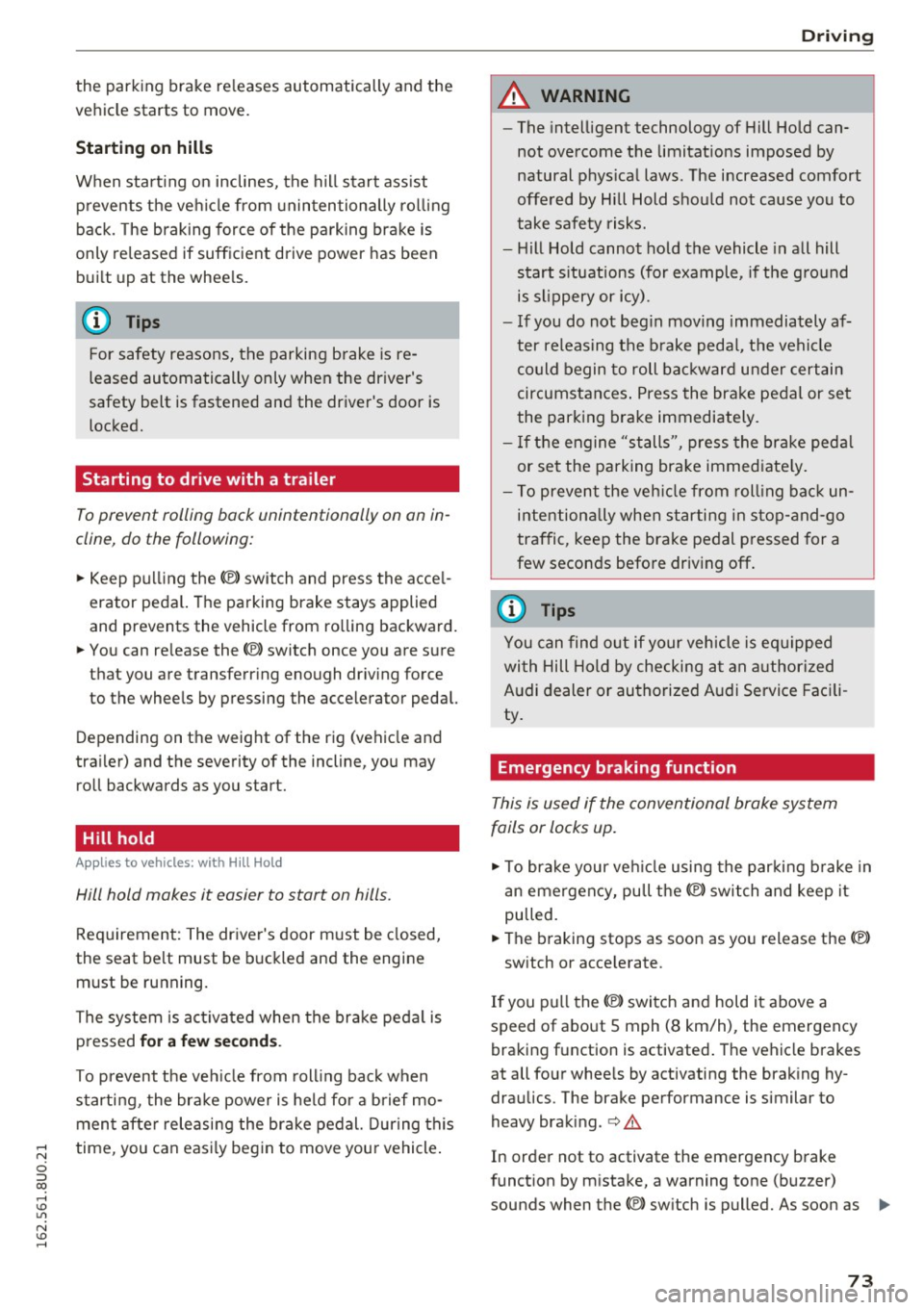
the parking brake releases automatically and the
vehicle starts to move.
Starting on hills
When start ing on inclines, the hill start ass ist
prevents the vehicle from unintentionally roll ing
back. The braking force of the parking brake is
only released if sufficient drive power has been
bui lt up at the whee ls.
(D Tips
For safety reasons, the parking brake is re
leased automatically only when the driver's
safety belt is fastened and the driver's door is
locked.
Starting to drive with a trailer
To prevent rolling back unintentionally on an in
cline, do the following:
.. Keep pulling the<®> switch and press the acce l
erator pedal. The parking brake stays applied
and prevents the vehicle from ro lling backward.
.. You can re lease the<®> switch once you are sure
that you are transferring enough dr iving force
to the whee ls by pressing the accelerator pedal.
Depending on the weight of the rig (vehicle and
trailer) and the severity of the incline, you may
roll backwards as you start.
Hill hold
A ppl ies to vehicles: with H ill Hol d
Hill hold makes it easier to start on hills .
Requirement: The driver's door must be closed,
the seat belt must be buckled and the engine
must be running.
The system is activated when the brake pedal is
p ressed
for a few seconds.
To prevent the vehicle from roll ing back when
starting, the brake power is held for a brief mo
ment after releasing the brake pedal. During this
~ time, you can easi ly begin to move you r vehicle .
ci ::, co ,....,
A WARNING
- The intelligent technology of Hill Hold can
not overcome the limitat ions imposed by
natural physical laws. The increased comfort
offered by Hill Hold should not cause you to
take safety risks.
- Hill Hold cannot hold the vehicle in all hill
start situations (for example, if the g round
is slippery or icy).
- If you do not beg in moving immediately af
ter releasing the brake peda l, the vehicle
could begin to roll backward under certain
circumstances . Press the brake pedal or set
the parking brake immediately.
-If the engine "stalls", press the brake pedal
or set the parking bra ke immediate ly.
- To prevent the vehicle from roll ing back un
intentionally when starting in s top-and-go
traffic, keep the brake pedal pressed for a
few seconds before driving off .
(D Tips
You can find out if your vehicle is eq uipped
wi th Hill Hold by checking at an authorized
Audi dealer or authorized Audi Service Facili
ty.
Emergency braking function
This is used if the conventional brake system
fails or locks up.
.,. To brake your veh icle using the parking brake in
an emergency, pu ll the(®) switch and keep it
pulled.
.. The braking stops as soon as you release the<®>
switch or acce lerate .
If you pu ll the(®) switch and hold it above a
speed of about 5 mph (8 km/h) , the emergency
braking function is activated. The vehicle brakes
at all four whee ls by activating the braking hy
draulics. The brake performance is similar to
heavy brak ing .
c::> .&.
In order not to activate the emergency brake
function by mistake, a warning tone (buzzer)
sounds when the(®) switch is pulled. As soon as .,.
73